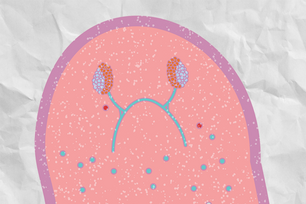
Whitehead Member Peter Reddien has created a transcriptome atlas for the planarian flatworm.
Christopher Fincher/Whitehead Institute
New Whitehead scientist uncovers the regenerative secrets of flatworms
CAMBRIDGE, Mass. — Chop a planarian flatworm in half and you end up with two healthy, wiggly worms. Unfortunately, not so with a lab mouse or fruit fly. Peter Reddien, who joins the Whitehead faculty as Associate Member this August after completing a postdoctoral fellowship at the University of Utah, is determined to find out why.
Identifying the molecular mechanisms that give planarians such remarkable abilities will shed light on the little-understood world of organ and tissue regeneration, as well as aid a more general understanding of adult stem cells.
The planarian Schmidtea mediterranea challenges common perceptions about the capabilities of biological systems. When severed, both head and tail fragments re-grow into complete animals. New tissues and organs are created by neoblasts—adult stem cells that share certain characteristics with embryonic stem cells and can differentiate into essentially all cells found in adult animals. A similar process occurs in normal intact adults, in which neoblast progeny cells continually replace aged cells. Additionally, if nutrition is limited, planarians can exhibit “de-growth”—eliminating cells while maintaining the form and function of the various organ systems of the animals. The genetic and molecular mechanisms that make such processes possible are almost completely unknown.
At Whitehead, Reddien will continue to create a body of knowledge and research tools that will establish the planarian as a model organism to study the molecular genetics of regeneration. (The classic invertebrate model organisms, the Drosophila fruit fly and the C. elegans worm, cannot efficiently regenerate tissues as adults.) He and his colleagues at the University of Utah’s Department of Neurobiology and Anatomy developed methods for high-throughput RNA interference (RNAi), which uses customized RNAs to silence production of proteins from a given gene. Exploiting these methods, Reddien led the first large-scale study of gene function in planarians, discovering multiple genes needed for regeneration.
He also is one of three members of a consortium to sequence the S. mediterranea genome, working in collaboration with the Genome Center at Washington University in St. Louis.
“We’re very excited to be welcoming such a bold, creative young scientist to the Whitehead faculty,” says Whitehead Member and Interim Director David Page. “I have no doubt that Peter will put the planarian flatworm on the map as a model organism to study regeneration.”
Reddien obtained his PhD in biology from Massachusetts Institute of Technology. As a graduate student, he discovered that engulfment of dying cells by other cells helps to ensure programmed cell death in C. elegans, identified an engulfment signaling pathway, and found new regulators of cell death in a genetic screen, among other accomplishments. He carried out his undergraduate studies in molecular biology at the University of Texas at Austin where he graduated magna cum laude. In addition, Reddien received a National Science Foundation graduate fellowship (2000), a Howard Hughes Medical Institute postdoctoral fellowship at MIT (2002), and a Helen Hay Whitney Foundation postdoctoral fellowship (2003).
Topics
Contact
Communications and Public Affairs
Phone: 617-452-4630
Email: newsroom@wi.mit.edu


